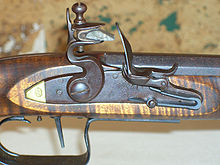Flintlock
The flintlock ( French lock , battery lock ) is a trigger mechanism for muzzle-loading firearms that ignites with a flint . It was the successor to the matchlock and the wheel lock and was subsequently replaced by the percussion lock .
history
The first preforms existed as early as the 16th century ( snap locks ), which, however, were not yet fully developed in terms of design and did not function reliably enough. In the early 17th century the system was improved and gradually gained acceptance because it wasn't quite as weather dependent as the matchlock and because you could always be ready to fire without using up a match. From 1704 it had prevailed in all armies and almost completely displaced the matchlock. Only the cavalry used the wheel lock for longer. The snap lock was later introduced to the cavalry as it was cheaper and easier to maintain.
Ignition mechanism
A spring mechanism is cocked before the shot . The trigger unlocks the mechanism so that the tap with the clamped flint hits a metal flap (battery). A battery in the sense of weapon technology refers to a hardened metal flap that is part of the flintlock and closes the pan in which the ignition herb is contained. This opens the pan and sparks are generated by abrasion of the battery (not the flint), which fall into the particularly fine-grained and highly flammable powder (ignition herb) in the pan and ignite it. The igniter develops a jet flame and ignites the actual propellant charge through the ignition hole . When using binoculars prints , the problem revealed that although the time-short impulse expressed the engraver the trigger bar from the collet locking nut, the trigger bar but lay down again so quickly against the underside of the nut that its tip in the half or The safety catch caught and the tap stopped before it reached the battery. From the first quarter of the 18th century, the so-called fly, also known as a sling wedge, provided a remedy . It was a small component with a wedge-shaped cross-section that could swing back and forth in a triangular recess about twice as wide on the side or inside the nut. If you cocked the cock, the fly first lay over the full rest and the trigger bar could slide into the loading rest. As the tension continued, the fly jumped before half-rest. If the trigger was now pulled, it blocked the trigger bar's way into this position and the hammer could snap forward unhindered.
There were two variants for the rooster. The curved gooseneck tap was widely used. This shape allowed an effective impact, but had the disadvantage that the bent neck of the tap was a weak point and the tap could break. The other variant was a much more stable tap with an opening. This variant was particularly common with French military weapons. The lock was held on the shaft with screws from a lock counter plate.
In 1704 Gottfried Hantzsch from Nuremberg developed a conical ignition hole. The powder poured into the barrel trickled onto the pan, which made the step of manually pouring the pan superfluous. But there were also disadvantages. A conical ignition hole burned out faster, ie it got wider over time. It also allowed more propellant gas to escape, which on the one hand reduced the propulsive force for the projectile and on the other hand annoyed the gunner in the formation adjacent to the side.
Later flintlocks sometimes had a spark guard. The guard covered the pan and was intended to protect the shooter's face and eyes from the spark.
Lock types
The flintlock was used in different variants and stages of development. The first variant was the snap lock or snap valve lock . The pan was closed with a lid like the matchlock, but the battery was still separate. These locks usually did not have a loading slot either, as they were secured by folding away the battery and also by means of a pan lid.
The Miquelet Castle (or a la catalana ) was a specialty from Spain . The main spring for triggering the cock was outside the lock and the battery had a straight top and mostly vertical indentations on the friction surface. The screw for the flint was provided with a ring to make it easier to tighten.
In the 19th century , the more reliable percussion lock with primer came on and quickly replaced the flintlock.
Other uses
Some early land mines, such as Fougassen, were detonated with stone locks. Flintlocks were also used to launch Congreve rockets .
See also
Individual evidence
- ↑ Brockhaus' Kleines Konversations-Lexikon, fifth edition, Volume 1. Leipzig 1911., p. 161. [1]
- ^ Heinrich Müller: The army in Brandenburg and Prussia from 1640 to 1806. Volume 1. The armament , Brandenburgisches Verlagshaus , 1991, ISBN 3-327-01072-2 , pp. 85-86
- ↑ Erich Haenel: "Alte Waffen", Verlag RC Schmidt & Company, 1913, p. 102 [2]
- ↑ Martin Biddle, Jonathan Hiller, Ian Scott: Henry VIII's Coastal Artillery Fort at Camber Castle, Rye, East Sussex , English Heritage Publishing , 2014, ISBN 9781848021624 p. 198 [3]
- ↑ British Rockets. Fort McHenry - National Monument and Historic Shrine, archived from the original on April 3, 2014 ; accessed on June 14, 2013 .
Web links
- Flintlock mechanism with pictures (in English)
- Technical function of the flintlock with theoretical approaches ( Memento from September 24, 2008 in the Internet Archive )















